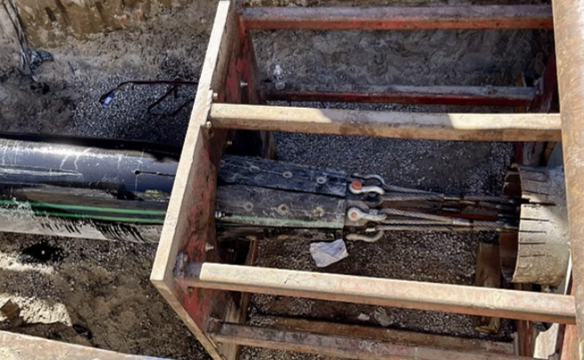Compressed Fit HDPE Liner
Trenchless technology Overview
Compressed Fit HDPE Lining Systems also known as Swagelining or Titelining involves pulling a HDPE liner pipe string through a die or roller box to temporarily reduce the outside diameter of the liner. The HDPE liner is sized to the internal diameter of the existing pipeline and forms a close or interactive fit with the host pipe after installation. Once the liner has passed through the reduction die, it is able to be installed inside the existing host pipe while in a compressed state. After the liner has reached the receiving pit and pull tension has eased, the liner pipe will naturally swell in diameter.
The HDPE liner pipe can be installed with a winch or pipe bursting machine and is best suited for rehabilitating pipelines that span long distances, have few bends or fittings and have a consistent internal diameter. This trenchless lining solution can be pulled through long radius sweeps or minor deflections but not through fittings. It can be used to rehabilitate pipelines ranging in size from 2 inches to 63 inches in diameter and is able to be installed in lengths in excess of 3,000 LF between excavations. Compressed Fit HDPE lining gained widespread acceptance in the 1980’s and has a proven track-record in the municipal, oil & gas, mining, industrial, and offshore markets.

Applications
Compressed fit lining is a viable trenchless pipeline rehabilitation solution for municipal applications like long distance water transmission lines or force mains. It is perhaps best suited to line new or rehabilitate existing high pressure steel pipelines in other markets. It can also be used to line a wide variety of host pipe materials including cast iron, ductile iron, Prestressed Concrete Cylinder Pipe (PCCP), Reinforced Concrete Pipe (RCP), Asbestos Cement (AC), etc.
If the existing host pipe is considered fully deteriorated, the maximum pressure rating of a structural DR17 HDPE piping system is 125psi. If the Compressed Fit HDPE is intended to be an interactive, non-structural lining solution that is not designed to act as a structural component; it can be operated in excess of 2,500psi when used in conjunction with steel pipe.
Another benefit is the minimal impact to a pipeline’s flow capacity. Due to the roughness coefficient of HDPE combined with the liner’s minimal wall thickness; the slight reduction in the pipeline’s cross sectional area is negated.
In summary, Compressed Fit HDPE lining is a fantastic trenchless rehabilitation solution if the pipeline is long, straight with a consistent internal diameter.
Capabilities
- Diameter Range: 2″ – 63″
- Maximum Installation Length: 3,000 LF
- Maximum Temperature: 180deg F (Structural) / 190deg F (Non-Structural)
- Pressure Rating: 150psi (Structural) / 2,500deg F (Non-Structural)
- Liner Wall Thickness: Based on Dimension Ratio (Structural)
- Direction Changes: Long Radius Sweeps
- Cost: $-$$$
- Roughness Coefficient: 150


